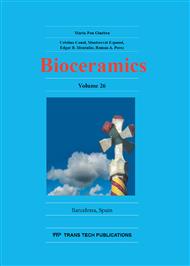[1]
W. E. Brown, L. C. Chow, U.S. Patent, 4, 518, 430. (1985).
Google Scholar
[2]
Y. Miyamoto, K. Ishikawa, M. Takechi, T. Toh, T. Yuasa, M. Nagayama, K. Suzuki, Histological and compositional evaluations of three types of calcium phosphate cements when implanted in subcutaneous tissue immediately after mixing, J. Biomed. Mater. Res. 48 (1999).
DOI: 10.1002/(sici)1097-4636(1999)48:1<36::aid-jbm8>3.0.co;2-i
Google Scholar
[3]
M. Aizawa, Y. Haruta, I. Okada, Development of novel cement processing using hydroxyapatite particles modified with inositol phosphate, Arch. BioCeram. Res. 3 (2003) 134–138.
Google Scholar
[4]
Y. Horiguchi, Y. Yoshikawa, K. Oribe, M. Aizawa, Fabrication of chelate-setting hydroxyapatite cements from four kinds of commercially-available powder with various shape and crystallinity and their mechanical property, J. Ceram. Soc. Jpn. 116 (2008).
DOI: 10.2109/jcersj2.116.50
Google Scholar
[5]
T. Konishi, Z. Zhuang, M. Mizumoto, M. Honda, M. Aizawa, Fabrication of chelate-setting cement from hydroxyapatite powder prepared by simultaneously grinding and surface-modifying with sodium inositol hexaphosphate and their material properties, J. Ceram. Soc. Jpn. 120 (2012).
DOI: 10.2109/jcersj2.120.159
Google Scholar
[6]
T. H. Dao, Polyvalent cation effects on myo-inositol hexakis dihydrogenphosphate enzymatic dephosphorylation in dairy wastewater, J. Environ. Qual. 32 (2003) 694–701.
DOI: 10.2134/jeq2003.6940
Google Scholar
[7]
C.J. Martin, W.J. Evans, Phytic acid-metal ion interactions. II. The effect of pH on Ca(II) binding, J. Inorg. Biochem. 27 (1986) 17–30.
DOI: 10.1016/0162-0134(86)80105-2
Google Scholar
[8]
S. Takahashi, T. Konishi, K. Nishiyama, M. Mizumoto, M. Honda, Y. Horiguchi, K. Oribe and M. Aizawa, Fabrication of novel bioresorbable b-tricalcium phosphate cement on the basis of chelate-setting mechanism of inositol phosphate and its evaluation, J. Ceram. Soc. Jpn., 119 (2011).
DOI: 10.2109/jcersj2.119.35
Google Scholar
[9]
T. Konishi, S. Takahashi, Z. Zhuang, K. Nagata, M. Mizumoto, M. Honda, Y. Takeuchi, H. Matsunari, H. Nagashima, M. Aizawa, Biodegradable b-tricalcium phosphate cement with anti-washout property based on chelate-setting mechanism of inositol phosphate, J. Mater. Sci.: Mater. Med., 24 (2013).
DOI: 10.1007/s10856-013-4903-8
Google Scholar
[10]
T. Konishi, S. Takahashi, M. Mizumoto, M. Honda, K. Kida, Y. Horiguchi, K. Oribe, K. Ishii, H. Morisue, Y. Toyama, M. Matsumoto, and M. Aizawa, Comparative study on bioresorbability of chelate-setting cements with various calcium-phosphate phase using rabbit model, Key Engineering Materials, 529-530 (2013).
DOI: 10.4028/www.scientific.net/kem.529-530.167
Google Scholar
[11]
T. Konishi, M. Mizumoto, M. Honda, Y. Horiguchi, K. Oribe, H. Morisue, K. Ishii, Y. Toyama, M. Matsumoto, and M. Aizawa, Fabrication of novel biodegradable a-tricalcium phosphate cement set by chelating capability of inositol phosphate and its biocompatibility, J. Nanomater., 2013 (2013).
DOI: 10.1155/2013/864374
Google Scholar
[12]
H. Aoki, Medical Applications of Hydroxyapatite, Ishiyaku Euro America, Tokyo, 1994, p.174.
Google Scholar
[13]
T. Fujino, M. Aizawa, Preparation of apatite powder including bone minerals and its characterization, Arch. BioCeram. Res., 7 (2007) 175-178.
Google Scholar
[14]
M. Aizawa, T. Miki, Y. Yasutomi, M. Honda and H. Yoshimura, Hydroxyapatite ceramics including bone minerals promote differentiation of osteoblasts derived from rat bone marrow cells, Key Engineering Materials, 493-494 (2012)320-324.
DOI: 10.4028/www.scientific.net/kem.493-494.320
Google Scholar
[15]
M. S. Sader, K. Lewis, G. A. Soares, R. Z. LeGeros, Simultaneous Incorporation of Magnesium and Carbonate in Apatite: Effect on Physico-chemical Properties, Mater. Res., 16 (2013)779-784.
DOI: 10.1590/s1516-14392013005000046
Google Scholar


